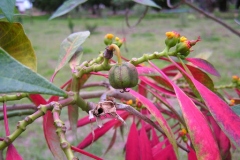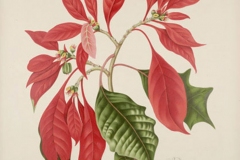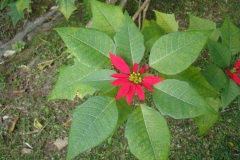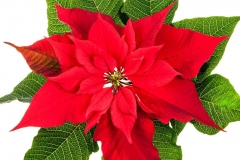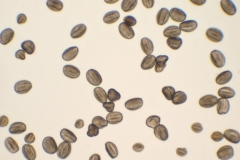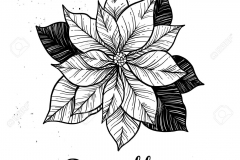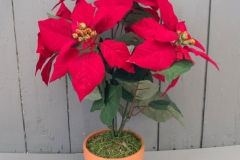| Poinsettia Quick Facts | |
|---|---|
| Name: | Poinsettia |
| Scientific Name: | Euphorbia pulcherrima |
| Origin | Mexico and Central America |
| Shapes | Small and three lobed capsule |
| Health benefits | Support for gonorrhea, respiratory tract infection, malaria, eczema, asthma, warts, toothache, fever and cutaneous problems |
| Name | Poinsettia |
|---|---|
| Scientific Name | Euphorbia pulcherrima |
| Native | Mexico and Central America, but it can be found in subtropical areas around the world today |
| Common Names | Poinsettia, Christmas-flower, Christmas-star, Common poinsettia, Dazzle, Lobsterplant, Lobster plant, Mexican flame leaf, Mexican flameleaf, Mexican poinsettia, Paintedleaf, Garden poinsettia |
| Name in Other Languages | Afrikaans: Poinsettia Albanian: Poinsettia Amharic: Poinsettia-poinˈsedə, poinsettia Arabic: Albuinsitia (البوينسيتيا), bint alqunsul (بنت القنصل) Armenian: Sints’ettia (սինցետտիա), poinsettia, puansettia (պուանսետտիա) Assamese: Lalpat, Lal-pata Azerbaijani: Poinsettia Basque: Poinsettia, Pazko lorea Bengali: Poinsettia-poinˈset(ē)ə, poinsettia, Lālapātā (লালপাতা) Belarusian: Puansettiya (пуансеттия) Bosnian: Poinsettia Brazil: Papagaio, rabo-de-arara Bulgarian: Koledna zvezda (коледна звезда) Burmese: Poinsettia-poinˈset(ē)ə Catalan: Poinsettia, flor de Nadal, ponsètia Cebuano: Poinsettia Chichewa: Poinsettia Chinese: Yīpǐnhóng (一品红), Shèngdàn hóng (聖誕紅) , Xing xing mu, Lao lai jiao Corsican: Poinsettia Croatian: Poinsettia, Božićna zvijezda Czech: Vánoční hvězda, Poinsettia, pryšec překrásný, prýštec najkrajší, pryšec nádherný Danish: Julestjerne Dotyali: Laalupatya phool (लालुपत्या फूल) Dutch: Kerstster, poinsettia, prachtwolfsmelk English: Poinsettia, Christmas-flower, Christmas-star, Common poinsettia, Dazzle, Lobsterplant, Lobster plant, Mexican flame leaf, Mexican flameleaf, Mexican poinsettia, Paintedleaf, Garden poinsettia Esperanto: Poinsettia, Belega eŭforbio Estonian: Poinsettia, jõulutäht Filipino: Poinsettia Finnish: Joulutähti French: Poinsettia, Euphorbe écarlate, euphorbe superbe, rose de Noël, étoile de Noël, poinsettia rouge Frisian: Poinsettia Galician: Poinsettia, Flor do Nadal Georgian: P’ointset’ia (პოინცეტია), poinsettia German: Weihnachtsstern, Poinsettia, Adventsstern, Greek: Alexandrinó (Αλεξανδρινό), Poinsettia Gujarati: Pointsettia-poinˈset(ē)ə, poinsettia Haitian Creole: Pwensètya Hausa: Hakanar, poinsettia Hawaiian: Poinsettia Hebrew: פויסטיה Hindi: Poinsettia (poinˈset(ē)ə) Hmong: Poinsettia Hungarian: Mikulásvirág Icelandic: Skáldsaga, Skáldskapur Igbo: Poinsettia Ilocano: Paskuas Indonesian: Poinsettia, Kastuba Irish: Poinsettia Italian: Poinsettia, stella di Natale Japanese: Poinsechia (ポインセチア), Shoujouboku (ショウジョウボク) Javanese: Poinsettia Kannada: Poyinseṭiyā (ಪೊಯಿನ್ಸೆಟಿಯಾ), poinsettia, Poyan seṭiyā (ಪೊಯನ್ ಸೆಟಿಯಾ) Kapampangan: Depaskua Kazakh: Poinsettia (поинсеттия), Puansettiya (Пуансеттия) Khmer: Poinsettia Kinyarwanda: Poinsettia Korean Poinsettia (포인세티아) Kurdish: Poinsettia Kyrgyz: Poinsettia Lao: Poinsettia (poinˈset(ē)ə) Latin: Poinsettia Latvian: Poinsettia, krāšņā eiforbija Lithuanian: Puansetija, poinsettia, Puošniausioji karpažolė Luxembourgish: Poinsettia Macedonian: Понкеттија-Ponkettija, poinsettia Malagasy: Poinsettia Malay: Poinsettia, Dènok, Godong ratjoon, Kastooba, Ratjoonan Malayalam: Poinsettia, peā’insetti’a (പൊഇംസെത്തിഅ), pēāyinseṟṟiya (പോയിൻസെറ്റിയ) Maltese: Poinsettia Maori: Poinsettia Marathi: Poeentasetiya (पॉईंटसेटिया), poinsettia Mongolian: Poinsettia Myanmar (Burmese): Poinsettia Nahuatl: Cuetlaxōchitl Nepali: Pointsettia-poinˈsedə, poinsettia, Lālupātē phūla (लालुपाते फूल) Netherlands: Prachtwolfsmilk North Frisian: Julstäär Norwegian: Julestjerne Odia: Poinsettia Oriya: Poinsettia Pashto: ټکی Persian: اشاره دار Polish: Poinsecja, gwiazda betlejemska, poinsecja nadobna, wilczomlecz nadobny, wilczomlecz piękny Portuguese: Poinsétia, Flor-de-papagaio, Folha-de-sangue, Papagaio, bico-de-papagaio, cardeais, estrela-de-natal, estrela-de-Natal, flor-de-janeiro, flor-de-Santo-Antônio, flor-de-São-João, jangada, manhãs-de-Pascoa, rabo-de-arara, Punjabi: Pu ā iṭasi ā (ਪੁਆਇੰਟਸਿਆ) Romanian: Poinsettia Russian: Puansettiya (пуансеттия), Molochai krasivyeishij (Молочай красивейший), Puansettiia (Пуансеттия) Samoan: Poinsettia Scots Gaelic: Poinsettia Serbian: Poinsettia (поинсеттиа), Božićna zvezda (Божићна звезда) Sesotho: Poinsettia Shambala: Božićna zvezda Shona: Poinsettia Sindhi: پوليشيا, پوليشيا Sinhala: Poinsettia Slovak: Vianočná hviezda, prýštec najkrajší Slovenian: Poinsettia, božične zvezde Somali: Poinsettia Spanish: Flor de Pascua, Poinsettia, Flor de noche buena, Flor de Santa Catarina, Pascuero, bandera, catalina, estrella de Navidade, guacamayo, nochebuena, pascuero, flor de Pascua, pastores, Božična zvezda Sudanese: Poinsettia Swahili: Poinsettia Swedish: Julstjärna Tagalog: Paskwa Tajik: Poinsettia-poinˈsedə, poinsettia Tamil: Poinsettia-poinˈsedə, Pōyiṉcēṭṭiyā (போயின்சேட்டியா), Ilai paddi, Mayil kaḷḷi (மயில் கள்ளி), Poo kaḷḷi (பூ கள்ளி), Poyṉ ceṭṭiyā (பொய்ன் செட்டியா) Tatar: Poinsetiya (поинсетия) Telugu: Poinsettia-poinˈsedə Thai: Sĕth (เซ็ท), Cheu eun (ชื่ออื่น), Poh pan (โพผัน), Song ra-doo (สองระดู), Khris̄t̒mās̄ (คริสต์มาส) Tongan: Laveʻimoa Turkish: Atatürk çiçeği Turkmen: Poinsettia Ukrainian: Puansettiya (пуансеттія), Molochay prekrasnyy (Молочай прекрасний) Urdu: Pointsettia Uyghur: Poinsettia Uzbek: Poinsettiya, poinsettia Vietnamese: Trạng nguyên, Thơm ngon Welsh: Poinsettia Xhosa: Mzantsiweb Yiddish: Poinsettia (פּאָינסעטטיאַ) Yoruba: poinsettia Zulu: Poinsettia |
| Plant Growth Habit | Deciduous to semi-evergreen tall, rangy shrubs or small trees |
| Growing Climates | Grows in moist, wet, wooded ravines, rocky hillsides, deciduous tropical forests and seasonally dry forests |
| Soil | Need well-drained, loamy, peat-based soil for good growth |
| Plant Size | 10 to 15 feet in height. Cultivated varieties are much smaller (up to 2 feet in height) |
| Leaf | Large, dark green, elliptic to oblong-elliptic with smooth edges (entire leaf margin) or pointed lobes and a long, thin tip. They emerge from smooth, green erect stems |
| Flower | Actual flowers are quite small, egg-shaped and occur at the base of the bracts (they are the yellow structures at the center of the brilliantly colored bracts) |
| Fruit Shape & Size | Fruit are very small and three lobed capsule with each lobe containing an oblong seed. Ripe fruit splits to release numerous seed. |
| Varieties |
|
| Plant Parts Used | Leaves and flowers |
| Lifespan | More than 2 years in the wild |
| Health Benefits |
|
| Precautions |
|
Plant Description
Poinsettia is a deciduous to semi-evergreen tall, rangy shrubs or small trees that normally grows to a height of 10 to 15 feet. Cultivated varieties are much smaller (up to 2 feet in height). The plant is found growing in moist, wet, wooded ravines, rocky hillsides, deciduous tropical forests and seasonally dry forests. The plant needs well-drained, loamy, peat-based soil for good growth. Place the plant in indirect sunlight for at least six hours per day. If direct sunlight can’t be avoided, diffuse the light with a shade or sheer curtain. Water your plant when the soil feels dry to the touch. Don’t overwater your plant, or allow it to sit in standing water. It is commonly used as a Christmas decoration and this makes its majority of exposures in the months of November, December, January, and February.
Leaves
Leaves are large, dark green, elliptic to oblong-elliptic with smooth edges (entire leaf margin) or pointed lobes and a long, thin tip. They emerge from smooth, green erect stems. The upper ones are lanceolate, 10 to 18 centimeters while the lower ones are entirely green, obscurely repand or slightly lobed, long-petioled, slightly hairy beneath. The upper ones, at the time of flowering are uniformly bright-red.
Flowers
Flowers (or cyathia) are borne at the stem tips in winter. The actual flowers are quite small, egg-shaped and occur at the base of the bracts (they are the yellow structures at the center of the brilliantly colored bracts). The bracts are actually modified leaves-in the species there usually are 8 to 10 bracts that are 4-7 in (10.2-17.8 cm) long. Bracts are similar in size to the leaves and are most often bright crimson red, but can also be cream coloured, pink, apricot, pale green or white. In double-flowered cultivars, the bracts become progressively smaller towards the center ultimately replacing the flowers. The flowers initially have red or green tips, but later release yellow pollen. The showy colored part of poinsettias that most people think is the flowers are actually these colored bracts (modified leaves). Many plants in this family ooze a milky sap. Poinsettia discards bracts after pollination.
Fruit
Fertile flowers are followed by very small and three lobed capsule with each lobe containing an oblong seed. Ripe fruit splits to release numerous seed.
Types of Poinsettias
There are well over 100 different poinsettia types. However, you won’t find such a large selection in shops. Here are some of the popular poinsettias types:
Solid Colors Poinsettias
You may be the most familiar with this type of Poinsettias. Poinsettias with solid red bracts are the most popular throughout the Christmas season, but you can also see poinsettias in solid pink, white, orange, yellow, and even purple.
Marble Poinsettias
These plants have lovely two-tone bracts with a deeper color in the center, such as red or pink, and lighter hues around the margins, such as yellow or cream.
Jingle Poinsettias
These poinsettias, sometimes known as glitter poinsettias, have bracts of one solid color, red or pink, with specks of a lighter color sprinkled throughout, such as white or cream. These plants stand out even more when paired with traditional all-red poinsettias.
Rose Poinsettias
Rose poinsettias feature bracts that curve slightly back and under, giving them the appearance of clusters of roses in full bloom, rather than the straight, pointed bracts. This kind is most commonly seen in conventional poinsettia red, although white and pink rose-shaped bracts are also available.
Health benefits of Poinsettia
Listed below are some of the well-known health benefits of Poinsettia
1. Parasite Killer
Poinsettia plant is used traditionally for getting rid of worms and other parasitic organisms in the GI tract. In other words, the plant is popular most especially during the Holidays for its superb anti-helminthic properties.
2. Stomach Flu Ender
Poinsettias are found effective in treating stomach flu. Roots of poinsettias are turned into paste and consumed. However, taking a lot of it is not recommended as it can cause vomiting.
3. Cure Diarrhea
Poinsettias are also commonly used by traditional healers in dealing with diarrhea, mostly the kind caused by microbes. Thanks to these Christmas plants, difficulties of diarrhea like dehydration may be nipped in the bud.
4. Snakebite First Aider
It is said that poinsettias are effective against snakebites. However, it’s a good idea to use it only as first aid. Whether you are sure or unsure that a snake is poisonous, it’s important to seek immediate medical attention when bitten.
5. Milk Booster
Poinsettias are known to help increase breast milk production. But just to be on the safe side, tell your doctor that you are not producing enough breast milk for your baby so that the necessary steps may be recommended.
6. Sexual Problem Solver
Based on traditional healing, the poinsettia plant is effective against an assortment of problems concerning the reproductive health. Some of them include gonorrhea, premature ejaculation and impotence.
7. Wart Eliminator
Sap from poinsettia leaves may be applied directly on warts repeatedly to have those pesky and unsightly growths eliminated. That’s because the said sap possess powerful antifungal properties.
8. Pimple Healer
Sap obtained from the leaves of the poinsettia plant may be used for treating pimples. Traditional healers also use the sap in dealing with so many other skin problems, especially those that are caused by microbes.
9. Unwanted Hair Remover
Sap of poinsettias, regardless from which part of the plant it is obtained, can be used for removing unwanted hair. It is regarded as an all-natural depilatory, good for getting rid of pesky hair on your body.
Traditional uses and benefits of Poinsettia
- The plant has been used traditionally to treat skin conditions, warts, and toothaches.
- During the 14th-16th century the sap of Poinsettia was used to control fevers.
- Leaves are applied as poultice for erysipelas and a variety of cutaneous problems.
- Infusion of flowers is used as galactagogue.
- Plants used as emetic and cathartic.
- In Mexico, decoction of bracts taken by nursing women to increase the flow of milk, although the practice is considered dangerous by some.
- In Indonesia, E. pulcherrima is used as emetic, emmenagogue, and galactagogue, for treating tuberculosis, skin infections, and fractures.
- Sap from the plant has been used as a hair remover, and to encourage lactation in nursing mothers.
- It has antibacterial properties and has some reputation as a pain reliever particularly for toothache.
- Sap is also used to get rid of warts, pimples and other skin problems.
- In Mexico, poinsettia plant is used as a remedy to cure warts.
- Poinsettia plant is used as a remedy for the treatment of skin wounds, ulcers or skin diseases, such as labial herpes in Mexico.
- Poinsettia plant is used as an external remedy for inflammation processes in Mexico.
- It is suitable in case of arthritis, muscle or bone contusions, etc. (Apply heated leaves on the affected parts).
- In order to remove the excessive hair on the skin, latex of poinsettia has been used as a depilatory resource.
- Infusions of poinsettia are considered good for respiratory diseases: such as cold, cough, throat sore, bronchitis, etc. and for heart diseases.
- Sap extracted from Poinsettia was used in treatment of fever in the past.
- It has numerous medicinal properties which include its use in the treatment of gonorrhea, respiratory tract infection, malaria, eczema, asthma, and warts cure.
- Poinsettia has been used as a hair removal cream in Mexico and Guatemala.
- The latex has been used as a remedy for toothache and anti-vomiting agent.
- Poultices of leaves have been applied to treat aches and pains.
- The whole plant and its sap (latex) are used to make medicines despite the safety concern.
- In a related development it is said that the ethanol extract and water free extract of the plant leaves contain some wound healing properties.
Caring tips for Poinsettias
To keep poinsettias healthy for a long time is easy through proper care. Just follow the below poinsettia care instructions:
Right Environment
Caring for poinsettias starts with maintaining the right environment for the plants. They should be kept in a humid and semi-cool climate. Poinsettia care indoors requires them to receive bright yet indirect light with ample moisture. Poinsettias plants can be kept near other plants to scale up the humidity or near humidifiers. Often people keep moving these plants from cold to hot areas – this shouldn’t be done as it hampers their growth.
Extensive Watering
Poinsettias should be extensively watered. However, they are not to be overwatered. To ensure no overwatering, proper drainage should be present. Also, don’t keep poinsettia pots in saucers as the excess water drained will be collected leading to overwatering. To ensure there is no overwatering, water poinsettias till the compost surface appears completely moist.
Proper Fertilizing
Use suitable fertilizing techniques to ensure the proper growth of your poinsettias. Fertilize the poinsettias plants while they are blooming. Apply fertilizer every few weeks or once a month, or you can use houseplant fertilizer weekly to feed the plant.
Dropping Leaves
If the leaves of poinsettias are dropping or turning yellow, then find out the correct reason to revive their growth. You may be exposing the plant to extreme heat or dryness or watering it erratically. Keep the plant in the right environment and water adequately for good growth.
Proper Light Exposure
Poinsettias should receive adequate light for proper growth. However, their growth gets hindered due to direct sunlight. So, they should be kept in spots with indirect light.
Maintain the Soil Moisture
Keep a regular check on the soil moisture level for the healthy growth of your poinsettias. Use a pebble tray that will keep the soil and pot moist, prolonging the plant’s life.
Keep at Correct Temperatures
Poinsettias should be kept at the right temperature to boost their growth. Average room temperature is ideal for them. They are sensitive to extreme temperatures – making sure they are neither kept near any heat source nor any cold drafts. Too much heat or cold will shorten their life and blooming period.
Precautions
Poinsettia plants are less toxic than once believed. In most cases, poinsettia exposure causes only discomfort, including:
Mild, itchy rash
Skin contact with the sap of a poinsettia plant can cause a rash. If this happens, wash the affected area with soap and water. Apply a cool compress to ease itching.
Mild stomachache, vomiting or diarrhea
This can happen after eating part of a poinsettia plant. Severe signs and symptoms are unlikely. If you find a child eating a poinsettia plant, clear and rinse his or her mouth.
Eye irritation
If the sap of a poinsettia plant comes in contact with the eyes, they can become red and irritated. If this happens, flush the eyes with water.
Allergic reaction
Some people are more sensitive to poinsettia plants than are others. Reactions to poinsettia plants are more common among people who have latex allergies, since latex and poinsettia plants share several proteins. Also, if you’re allergic to avocados, bananas, chestnuts, kiwis and passion fruits you might have a greater chance of being allergic to poinsettia plants. In case of a severe reaction, seek prompt medical attention.
Other Facts
- Mexican Indians used to make a reddish-purple dye from the bracts.
- Poinsettia is a decorating indoor air purifying plant.
- The United States dedicated December 12 as National Poinsettia Day.
- The poinsettia is the national emblem of Madagascar.
- Poinsettia is one of the most popular house plants in the USA and Canada. Around 34 million plants are sold each year.
- Poinsettia is known as “Flower of the Holy Night” in Mexico and Guatemala, because it represents important part of Christmas celebration.
- Poinsettia is used for the Christmas decoration in churches for centuries.
- Aztecs used leaves of Poinsettia as a source of reddish-purple pigment that was used for dying of fabrics.
- To the Aztec Indians, the Poinsettia represented a symbol of purity and they called them “Cuetlaxochitl”.
References:
https://www.missouribotanicalgarden.org/PlantFinder/PlantFinderDetails.aspx?kempercode=b553
https://www.drugs.com/npp/poinsettia.html
https://gd.eppo.int/taxon/EPHPU
https://en.wikipedia.org/wiki/Poinsettia
https://plants.sc.egov.usda.gov/home/plantProfile?symbol=EUPU9
https://www.cabi.org/isc/datasheet/21373
https://www.itis.gov/servlet/SingleRpt/SingleRpt?search_topic=TSN&search_value=502548#null



